Tag Archive: SGD
December 26, 2014
by Carole Zangari -

Today, we head to Oklahoma for a chart that comes in handy when comparing SGDs during the feature match process. I especially love the distinction between features on the ‘Must Have’ list and those on the ‘Wish List.’ Thanks to the Oklahoma AT Center at the University of Oklahoma Health Sciences Center for this helpful resource!
Filed under: PrAACtical Thinking
Tagged With: assessment, device selection, feature match, Oklahoma AT Center, SGD
November 13, 2014
by Carole Zangari -
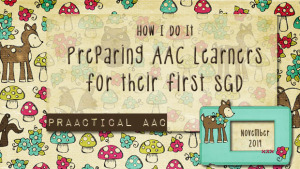
One of the greatest privileges of being an AAC SLP is getting to see kids grow and mature when they are given the appropriate communication tools and supports. The other day, I observed a tall, strong young man with significant autism arrive at this therapy session carrying a padded case. Once in the room, he gently laid it on the table, carefully opened it, took out his SGD, and gingerly placed it on the table in front of him. He had gotten his first SGD this summer as a tween, after having used the one in our AAC lab in his therapy sessions for the preceding months. There were some concerns that when he got his own SGD, he might be a little confused initially since this would be the first time he could actually take the device home. Additionally, some were worried that he might be rough with it... [Read More...]
Filed under: PrAACtical Thinking
Tagged With: expected behavior, How I Do It, SGD, social narrative
November 4, 2014
by Carole Zangari -

In one of my AAC classes, we’ve been talking about working collaboratively with vendors of SGDs and other AT in a way that is ethically responsible. Clearly, we look first to our ASHA SLP Code of Conduct, best practices, agency policies and procedures, and regulations (such as HIPAA and FERPA in the US). Secondly, we use a feature match process to guide the evaluation so that there is appropriate diversity in the communications being considered. Beyond that, here are some of the things we came up with. Open a dialogue and the roles and expectations of each party. If we are inviting a vendor in to provide some support, then it’s best to precede that with a frank conversation so that everyone is clear on how to proceed. Be clear about acceptable and unacceptable behaviors prior to the start of the collaborative activity. Having some guidelines written out in advance... [Read More...]
Filed under: PrAACtical Thinking
Tagged With: assessment, ethics, SGD, vendor
July 1, 2014
by Carole Zangari -

Have some time for AAC learning? Explore the LightWriter by Toby Churchill. LightWriter SL40 LightWriter SL40 User Guide (also available in other languages) Practice Exercises to Learn the LightWriter SL40 Quick Start Card Product Information and Frequently Asked Questions Where to Go for Help LightWriter Swift LightWriter Swift User Guide Practice Exercises to Learn the LightWriter Swift Quick Start Guide Where to Go for Help
Filed under: PrAACtical Thinking
Tagged With: LightWriter, SGD, text-to-speech
June 10, 2014
by Carole Zangari -

Picture exchange is powerful strategy for building symbolic communication in individuals with significant communication difficulties. We’ve posted about implementation of PECS a few times, and included references to research supporting its efficacy in some additional posts. Today, we look at a sequence of three single subject design experimental studies by Dr. Jeff Sigafoos and other researchers that looked at how the use of picture exchange and AAC devices (SGD condition) impacted social interaction. In the initial study, the team taught requesting skills either with picture exchange or AAC devices and then looked to see if there were any changes in social interaction. They hypothesized that the physical act of picking up a symbol and giving it to someone, as with the picture exchange condition, would make the learner less likely to turn away from his communication partner. So, in addition to measuring how well the participant learned to make requests,... [Read More...]
Filed under: PrAACtical Thinking
Tagged With: Jeff Sigafoos, picture exchange, research, Research Tuesday, SGD
March 7, 2014
by Carole Zangari -
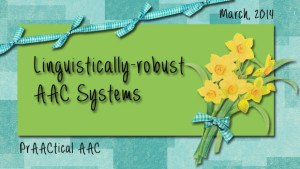
At the NCACA conference last month, a few of us were talking about what it means to have an AAC device or app with a strong language system, something Gail Van Tatenhove and I wrote about a few years ago in this book. Linguistically-robust language systems are those that will allow someone to construct grammatically correct utterances. Think of the different SGDs or AAC apps that you worked with this week. If you could use them to recreate the last 30 minutes of ‘talk time’ that you had without spelling out too many of the words, chances are pretty good that it is a linguistically-robust system. That led to us asking ourselves and others a question. “What do you look for in terms of a language system when you’re considering SGDs or AAC apps for a learner who has the potential to (eventually) construct grammatically correct utterances?” Keep in mind... [Read More...]
Filed under: PrAACtical Thinking
Tagged With: generative language, SGD
February 20, 2014
by Carole Zangari -
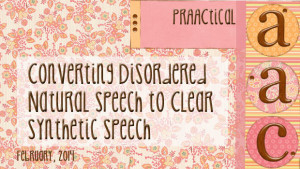
One of the exciting things about being in an AT-related field, is watching new developments in technology. Many of us have worked with individuals who have intact language and severely impaired speech. When we last wrote about ViVoca (Voice-Input, Voice-Output Communication Aid), it generated a lot of interest as a potential support for some individuals who struggle with face-to-face communication. The research efforts are lead by Dr. Mark Hawley, Professor of Health Services Research at the University of Sheffield, in the UK. We’re pleased to be able to share a video showing this emerging technology in aaction. Direct Link: http://www.youtube.com/watch?v=qTyjlM2jYMs
Filed under: PrAACtical Thinking
Tagged With: intelligibility, research, SGD, speech intelligibility, technology, ViviVoca
November 5, 2013
by Carole Zangari -

This week in Teach Me Tuesday we’re learning more about Accent from Prentke Romich Company (PRC). Here are the learning resources we’ll be using. Easy Start Manual NuVoice Software Manual Accent 700 Easy Start Manual Accent 700 Hardware Manual Accent 700-SB Quick Start Manual Accent 700-SB Hardware Manual Accent 1000 Hardware Manual Accent 1200 Hardware Manual Download Demo Software Where to Go for Help and Accent Knowledge Base for Various Models: 1200, 1000, & 700 Models If you know of other applicable resources, please add them in a comment below. See you next time!
Filed under: PrAACtical Thinking
Tagged With: Accent, SGD, Teach Me Tuesday
August 15, 2013
by Carole Zangari -
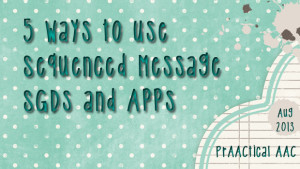
We’ve been having fun with sequenced message communicators and apps this summer. Yes, they’ve been around for a long time, but that doesn’t mean we use them to capacity. You just can’t beat those simple technologies for flexibility and ease of use. Here are some of the things we’ve been trying out. 1. Say hello: Record a variety of age appropriate greetings so that each time the AAC learner uses it, they greet their peers in different ways (e.g., Teen: “What’s up? Hey, how’s it going? Lookin’ good! Nice to see ya! Hey, what’s goin’ on?”). 2. Get the group’s attention: Allow AAC learners to help get their classmates’ attention (e.g., “Listen up, everyone! Mrs. Martinez has something to say”. “Hey, room 113-Mrs. M is ready for us to move on.” “Eyes forward, room 113.”). 3. Give instructions: Record steps to an activity so that the AAC learner can give... [Read More...]
Filed under: PrAACtical Thinking
Tagged With: 5, five, sequenced message, SGD
June 7, 2013
by Carole Zangari -
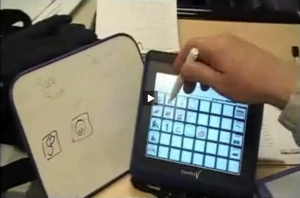
Adults use multiple modes of communication, too. This video from the Dynavox Implementation ToolKit gives us some great examples of adults using varied strategies for communication.
Filed under: Video of the Week
Tagged With: adults, modes of communication, Multimodal, SGD









